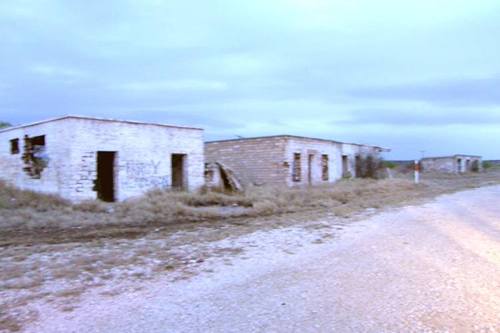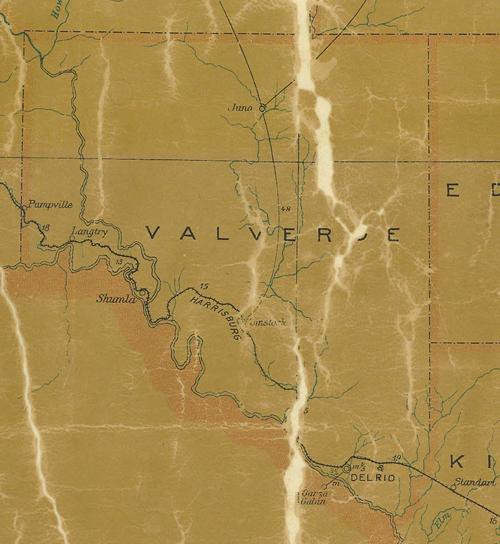|
It’s
been a long time since a train stopped at Shumla,
a West Texas ghost town as ethereal as steam escaping from a coal-fired
locomotive.
Shumla had its beginning in 1881 as construction crews raced to connect
the eastern and western halves of America’s second and southern-most
transcontinental rail line. Once a tent city stretching more than
a mile long, it teemed with hundreds of Chinese and European-immigrant
graders and track layers as well as crew bosses, engineers, and a
variety of camp followers including peddlers, whiskey sellers, gamblers
and working women you wouldn’t feel comfortable introducing to mom.
One of the railroad engineers had been to Eastern Europe and thought
the area 15 miles west of Comstock
in present Val Verde
County looked like the countryside around the Ottoman fortress
of Shumla in the Balkans. Accordingly, the Southern Pacific put the
spot on its system map as Shumla,
Texas.
Though Shumla’s original reason for existence ended with the completion
of the tracks, steam-powered trains needed to take on water and coal
about every 30 miles. Once regular east-west traffic began, Shumla
became a section point with a depot, water tank and foreman’s house.
Despite its depot, Shumla did not have enough population to support
a post office until 1906. But Shumla never saw better days than when
the construction workers camped there.
Shumla was only one of many construction camps along the SP right
of way, though not all of them survived as towns. The most common
indications of camp sites are occasional sets of stone walls about
two-and-a-half feet tall once used as canvas tent bases.
Professional
archeologists and relic hunters over the years have found woks, opium
bottles, fragments of tea cups and Chinese coins around these camp
sites in addition to other trash associated with construction and
temporary human occupation.
At Shumla, a 1995 archeological survey noted the remnants of a rectangular
dry-laid stone structure about 20 feet wide and 70 feet long, a collapsed
dome oven used for bread baking, a piled stone forge for blacksmith
work and rock piles suggesting tent sites.
Just west of Shumla, the archeologists found a toppled limestone grave
marker with an inscription in crude Danish. Translated to English,
it read: |
Here Under Rests
That Dear Child
B.K. Kristiansen
Born 181. 1882
Died 71. Same Year. |
Given the date,
the headstone – which has since disappeared – indicates the grave
of a European construction worker’s child. If that’s correct, it demonstrates
that some of the rail workers had their families with them as they
moved east at a rate up to two miles a day.
All
that’s left of Shumla today is an old concrete motel on U.S. 90 dating
from the early automotive era, the word “Cabins” still faintly visible
in white paint, the shell of an old grocery store and the walls of
one house. |
 |
|
The motel closed
in the late 1940s or early 1950s and the grade has gone downhill
for Shumla ever since.
On the old Ross Ranch about a mile west of its original location
is the 1882 depot, a frame structure moved across the highway when
the SP discontinued the Shumla station as more efficient diesel
engines replaced the old coal-burners. A bit farther west of the
ramshackle depot is the original section foreman’s house, with some
later add-ons.
A few years back, retired consulting archeologist
Elton Prewitt of Austin
bought 270 acres in the Shumla area. That real estate transaction
coincided with something of resurgence for Shumla.
On a ranch not far from the original town has risen a new Shumla,
a collection of modern buildings that nationally recognized prehistoric
rock art expert Dr. Carolyn Boyd operates both as a base for ongoing
research and as the setting for a unique school. With Shumla as
an acronym, the school’s mission statement is "Studying Human Use
of Materials, Land and Art."
Situated in one of the richest archeological areas in the world
(with more than 2,000 recorded sites and more than 300 known pictograph
sites), the non-profit Shumla School is a one-of-a-kind facility.
Boyd, her staff and volunteers are using the study of ancient rock
art and archeology as a way to engage not-so-easily-engaged children
and to transform them into eager learners and problem solvers.
Additionally, the Shumla school is a rock art research center gaining
international attention. Three top scientists in the field of rock
art who have lectured at the school – Dr. James Keyser, retired
U.S. Forest Service archeologist; Dr. David Whitley of the Arizona
State University and Dr. Jean Clottes of the French Ministry of
Culture all have declared that the area around Shumla deserves inclusion
in the United Nation's World Heritage List of 851 unique world-wide
cultural or natural sites.
As for the surviving structures of the railroad era, Prewitt – president
of the Shumla school’s board – hopes some individual or organization
interested in railroad
history can acquire the old Shumla depot before it is completely
gone and restore it.
“We’d sure like to have it at the Shumla School,” he said.
© Mike Cox
"Texas Tales"
January 18, 2008 column
|
 |
| Books
by Mike Cox - Order Here |
|
|
